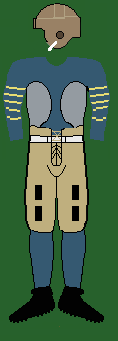1917 Michigan Wolverines football team
The players lost to the military included fullback Cedric "Pat" Smith, who had been elected to serve as captain of the 1917 team.
With only one returning backfield player, coach Yost converted tackle Tad Wieman into a fullback.
After an injury to starting quarterback Cliff Sparks in the second game, Archie Weston took over and became the team's second leading scorer with 78 points on 13 touchdowns.
The gathering then passed a resolution providing for the continuation of intercollegiate athletics with an emphasis on carrying out the recommendations of the Secretary of War.
[3] Several of Michigan veteran players (including Cedric "Pat" Smith, Philip Raymond, Willard Peach, John West, J. Vinton Hammels, and Frank Willard) were unavailable to the team due to military service.
With only one returning backfield player (Sparks), Yost converted tackle Tad Wieman into a fullback.
[4] On October 6, 1917, Michigan played its annual game against the team from Case Scientific School in Cleveland.
Substitutes appearing in the game for Michigan were Julius St. Clair (right end), Harold Rye (right halfback), Gerald Froemke (left halfback), Angus Goetz (right guard), Fred Hendershott (left end), Lowell Genebach (quarterback), William Fortune (right guard), and C. H. Graff (right tackle).
Michigan led 10–7 at the start of the fourth quarter, but Kalamazoo Normal scored a touchdown with four minutes remaining to take a 13–10 lead.
On the following drive, halfback Harold Rye returned the kickoff 35 yards, and Abe Cohn then had a long run.
[8] On Saturday, October 13, 1917, Michigan played the football team Mount Union College of Alliance, Ohio.
Left halfback Abe Cohn started the scoring with a touchdown run in the first quarter.
Additional touchdowns were scored by Gerald Froemke, Tad Wieman, Thomas Garrett, and William Cruse.
[12] The Detroit team came into the game with a reputation for its powerful offense, having scored 145 the week before against the University of Toledo.
Substitutes appearing in the game for Michigan were William Fortune (right guard), Oscar Cartwright (right end), L. O. Lindstrom (left tackle), Lowell Geneback (quarterback).
At halftime, the schools' combined bands led a detachment of troops onto the field and played the "Star Spangled Banner" and "The Victors".
Michigan's two touchdowns were scored by left halfback Gerald Froemke and fullback Tad Wieman.
Substitutes appearing in the game for Michigan were Lowell Genebach (right halfback), Lee Bonar (left end), William Cruse (left halfback), Alan Boyd (right end), Chester Morrison (right tackle), and Thomas Garrett (center).
Additional touchdowns were scored by Cliff Sparks, Joseph Hanish, and Abe Cohn.
[25] On November 17, 1917, Michigan played its annual rivalry game against the Penn Quakers football team.
After leaving the Big Ten Conference, Penn became Michigan's regular season-ending rivalry game.
In the 12 prior meetings, Michigan had won only four times, with the two teams playing to a scoreless tie in 1915.
[27] However, at the start of the second quarter, Michigan's quarterback Archie Weston was ejected from the game after a fight with two Penn players, Miller and Strauss.
[28] After Weston was ejected, Penn dominated the game, limiting Michigan to only seven yards from scrimmage in the entire second half.
Before the game started, the Northwestern crowd greeted the Wolverines warmly, and Walter Eckersall in the Chicago Tribune wrote: "That Michigan is welcomed in its return to the conference goes without saying.
"[31] Michigan played the game with three of its key starters, quarterback Archie Weston, center Oscar Lambert, and guard Frank Culver) sidelined by injury.
Michigan responded with a scoring drive capped by a three-year run by Gerald Froemke, but Tad Wieman missed the point after touchdown (PAT), and Northwestern remained in the lead, 7–6.

